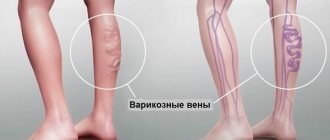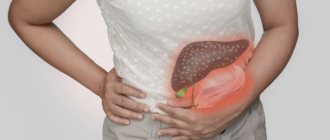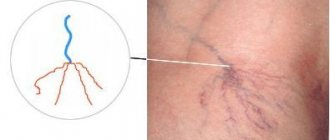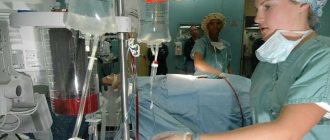Varicose veins are a disease in which the walls of the veins become thinner, the veins themselves become wide and tortuous, and the normal outflow of blood from them is disrupted. According to statistics, 30–40% of women suffer from varicose veins, and a considerable part of them encounter the disease for the first time during pregnancy. Varicose veins in pregnant women are dangerous primarily due to their complications. Disturbances in the circulatory system can worsen the child’s condition and cause complications during childbirth. Therefore, you cannot delay the treatment of varicose veins.
Causes of varicose veins during pregnancy
Varicose veins during the period of waiting for a child in obstetrics and gynecology are considered as a common complication of pregnancy. The main reasons for the development of pathology:
- Increase in circulating blood volume (CBV). An increase in blood volume in pregnant women is a natural process; this is necessary for the normal functioning of the fetoplacental system. But the vessels do not always cope with the increased load.
- Changes in hormonal levels. During pregnancy, the female body actively produces the hormone progesterone. It helps to relax the venous walls, as a result of which the veins lose their tone.
- Compression of blood vessels by the uterus. By the 3rd trimester, the uterus compresses the inferior vena cava and iliac veins. The outflow of blood from the lower extremities and pelvis is disrupted, and intravascular pressure increases.
- Increased blood clotting. The blood becomes thicker as the body tries to reduce possible blood loss during childbirth. This increases the risk of blood clots.
Predisposing factors to the development of varicose veins in pregnant women include excess weight and low physical activity.
Symptoms
The following symptoms occur with varicose veins:
- by the end of the day, the legs swell noticeably;
- there is a feeling of heaviness, burning, tingling in the legs;
- At night, cramps in the calves are possible;
- blue-violet spider veins appear;
- veins darken, dilate and bulge;
- Varicose nodes appear.
In the initial stages of the disease, a woman may only be bothered by swelling that goes away after a full night's rest. But if varicose veins are not treated, the situation will worsen.
Trophic ulcers may occur. Due to impaired blood supply, soft tissue necrosis will develop. This allows infection to penetrate into the wound.
Symptoms of varicose veins are limited not only to damage to the lower extremities. What else a pregnant woman may encounter:
- Varicose veins of the vulva and vagina. The venous pattern on the external genitalia intensifies, causing discomfort during sexual intercourse, defecation, and urination. There is a feeling of heaviness and burning in the perineal area.
- Varicose veins of the pelvic organs. A woman may be concerned about the appearance of blood in the stool and urine, or spotting during sexual intercourse. On ultrasound, dilation of the uterine veins will be noticeable.
- Hemorrhoids (varicose veins of the rectum). It is characterized by the appearance of painful nodes inside the rectum, which fall out during defecation.
The appearance of such complaints in pregnant women suggests that there is no time to waste; varicose veins need to be treated urgently.
Why are varicose veins dangerous?
Varicose veins during pregnancy lead to unpleasant consequences for the woman and child:
- Disturbances of uteroplacental blood flow. Vascular pathologies cannot be present locally in the body. Varicose veins will affect blood circulation in the mother-fetus system. The child will not receive enough oxygen and nutrients, which will lead to hypoxia, decreased heart rate, and intrauterine growth retardation. The child may be born weak and susceptible to infectious diseases.
- Venous bleeding. Occurs due to rupture of the affected vessel (usually due to mechanical trauma). Requires medical assistance (bleeding must be eliminated, the wound must be bandaged).
- PE (thromboembolism of the internal artery). With severe varicose veins, blood clots form in the veins. During natural childbirth, the body endures a high load. The blood clot can break off and travel into the pulmonary artery. If emergency assistance is not provided, this will lead to death.
An advanced stage of varicose veins in pregnant women sometimes becomes a contraindication to natural childbirth. Based on the results of examining the patient, the doctor may decide that the best option for delivery is a cesarean section, and thorough treatment of varicose veins can be carried out after childbirth.
From illness to illness
Many pregnant women are familiar with the feeling of malaise, accompanied by unpleasant sensations in the lower extremities. Functional chronic venous insufficiency is the first stage of venous disease with a feeling of heaviness in the lower extremities, sometimes with itching, paresthesia and, in some cases, cramps, often at night.
The possibility of thrombosis in pregnant women is 3-5 times higher than in other women. Sometimes blockage of the veins leads to their inflammation - thrombophlebitis. The blood clots that form in the veins can cause a serious and dangerous disease - pulmonary embolism. In addition, the risk of developing thrombosis remains for another 1.5 months after childbirth, especially if it is severe.
How to treat varicose veins during pregnancy
Treatment of varicose veins in pregnant women is carried out using the following methods:
- Compression therapy. Involves the use of elastic bandages and compression stockings. This allows you to reduce the diameter of the veins mechanically, protect the veins from overstretching, and improve the outflow of lymphatic fluid.
- Taking phlebotonics. These are drugs that can treat blood vessels. They increase their tone, reduce the permeability of the walls, and normalize blood flow. The drugs are produced in the form of tablets, gels, and ointments. The tablets should be taken according to the schedule, the ointment should be used 1 – 2 times a day.
- Taking anticoagulants. Anticoagulants are drugs that prevent blood clots and reduce blood clotting. Such medications for varicose veins should be used during pregnancy with caution, only as prescribed by a doctor and after making sure there are no contraindications.
An integral part of the comprehensive treatment of varicose veins should be physical therapy and lymphatic drainage massage.
In case of advanced varicose veins, injection sclerotherapy is possible. This is a low-traumatic method of treating varicose veins, in which a special drug is injected into the vessel through a game. Under its influence, the vein narrows and ceases to function, and the blood is directed to other vessels. How many injections will be required for the full course of treatment can only be said after consulting a doctor.
Medicines for varicose veins for pregnant women
Treatment of varicose veins during pregnancy is complicated by the woman’s condition. Surgical or minimally invasive methods cannot be used as therapy, because Such interventions can harm the woman and baby, and the risk of relapse of the disease is high. The use of medications and topical medications is also limited. Clinical studies have shown that only a number of oral medications, ointments and gels do not have a negative effect on fetal development. Let's look at the 2 most recommended remedies for varicose veins, which are allowed for expectant mothers:
- “Phlebodia 600” is a venotonic tablet with angioprotective properties. Phlebotonic based on diosmin has shown excellent therapeutic properties in the treatment of symptoms of varicose veins. The drug promotes the stability of the venous wall, increases vascular tone, improves lymphatic drainage and prevents the formation of blood clots. The tablets have a dose-dependent effect, so the medicine is used for a course of 1 to 6 months, depending on the severity of symptoms.
- "Detralex" is a drug intended to relieve symptoms of lymphovenous insufficiency of the lower extremities. The active substance also contains diosmin. Pharmacological properties are aimed at reducing the distensibility of veins, reducing capillary permeability and improving blood microcirculation.
You can find out how to take medications correctly or ask a phlebologist a question on our website in a special window.
Prevention of varicose veins
Basic measures to prevent the development of varicose veins in pregnant women:
- monitor weight gain, it should not be too fast;
- limit salt intake to prevent swelling;
- try to sleep on your left side - this will minimize pressure on large arteries and veins;
- avoid standing work in the 2nd and 3rd trimester of pregnancy;
- During the day, try to rest more, ideally in a horizontal position so that your legs are slightly higher than your head.
When the first symptoms of varicose veins appear, you should immediately consult a doctor. Consulting an obstetrician-gynecologist managing a pregnancy is not always enough.
The development of varicose veins requires contacting a qualified phlebologist. This is a specialist who studies, treats and prevents varicose veins, thrombosis, thrombophlebitis and other vein pathologies. He will examine the patient and suggest appropriate treatment tactics, taking into account the duration of pregnancy and the condition of the child.
The medical service provides treatment for varicose veins at a high level. Already at the consultation you will receive a complete diagnosis of the venous system.
There are the following forms of varicose veins in pregnant women:
- Varicose veins of the lower extremities
- Varicose veins of the pelvis
- Varicose veins of the external genitalia
- Pelvic venous congestion syndrome
- Right ovarian vein syndrome
- Varicose veins of the ovarian veins (varicoovarium)
Currently, there are 2 variants of the course of varicose veins of the small pelvis: varicose veins of the perineum and vulva, as well as pelvic venous congestion syndrome. It should be emphasized that this division is quite arbitrary, since in more than 50% of cases, varicose veins of the perineum and vulva provoke a violation of the outflow from the pelvis, and vice versa.
Varicose veins of the perineum and vulva
Occurs in 30% of women during pregnancy. The mechanisms of this condition are basically similar to those of varicose veins of the lower extremities. At the same time, the progressive varicose transformation of the perineal veins is aggravated by compression of the main veins of the retroperitoneal space (iliac and inferior vena cava) by the pregnant uterus. Outside of pregnancy, it persists in 2-10% of cases.
Pelvic Congestion Syndrome
The variety of clinical manifestations and imperfect diagnostics disguise it as various forms of gynecological (inflammatory diseases of the uterus and its appendages, endometriosis), urological (cystitis), surgical (colitis, Crohn's disease, etc.) and even orthopedic (diseases of the hip joint) pathology.
This disease is associated with varicose veins of the venous plexuses of the ovaries and the broad ligament of the uterus. The main mechanism is valvular insufficiency of the ovarian veins, leading to the discharge of blood and increased pressure in the venous plexuses of the pelvis. Predisposing factors may be uterine retroflexion, leading to bending of the broad ligament of the uterus, which impedes the outflow of venous blood, as well as various gynecological diseases (endometriosis, tumors of the uterus and ovaries). In recent years, the adverse effects of hormonal therapy and contraception have been discussed. The influence of hormonal levels is evidenced by the fact that the manifestations of pelvic venous congestion syndrome in the postmenopausal period become less pronounced.
The clinical picture of the disease is quite characteristic and manifests itself as varicose veins of the perineum, vulva, vagina, and lower extremities progressing as the pregnancy period increases (cosmetic defect). Signs of such violations will be:
- Itching in the area of dilated veins.
- A feeling of heaviness and bursting pain in the perineum, pelvis, swelling of the external genitalia, lower extremities.
- Dyspareunia (pain during sexual intercourse)
- Dysmenorrhea
- Severe premenstrual syndrome
- Pain when walking and exercising
- Pain along the veins
- General pain and aches in the legs
- Dysuric disorders.
- Fatigue.
- The development of acute varicothrombophlebitis and rupture of altered veins, which is accompanied by massive bleeding.
Thrombosis during pregnancy is the most important clinical problem. This is due to the high frequency of this condition as a cause of maternal mortality (20% of all causes). As is known, during pregnancy there is a tenfold increase in the risk of thrombosis. The incidence of thrombosis is 0.7 - 4.2/1000 in pregnant women versus 1/10,000 in non-pregnant women of childbearing age.
The critical stage of the thrombotic process is pulmonary embolism - a severe and very often fatal complication of thrombosis. PE is the leading cause of maternal mortality in Western obstetric practice - 0.7 cases per 1000 births (from 11% to 27%). The likelihood of venous thromboembolic complications (VTE) during cesarean section is 3-6 times higher. The risk of developing VTE returns to the level typical for non-pregnant women 6 weeks after birth.
The main WTO risk factors include the following:
- Age (> 35 years)
- C-section
- Weight > 80 kg
- Personal and family history of thrombosis
- Repeated births
- Ovarian hyperstimulation
- Prolonged immobilization
- Varicose veins
- Thrombophilia
The difficulty of treating HTO during pregnancy is as follows:
- Direct dependence on the duration of pregnancy (safe periods of pregnancy for active treatment tactics 7-8 weeks, 13-17 weeks, 23-27 weeks)
- Difficulty in selecting the type and dosage of an anticoagulant
- High probability of miscarriage and/or complications
- The need to resolve the complex issue of choosing treatment tactics
- The ethical problem of choosing to preserve life
- The problem of achieving compliance with the patient and her relatives
As for varicose veins of the lower extremities during pregnancy, this problem is very extensive and controversial. Patients with varicose veins who are planning a pregnancy should be clearly aware of the risks, adequately assess the danger that the disease poses not only to the mother, but also to the unborn child, so as not to then place all responsibility on doctors, who in this case will have very limited possibilities. Such responsibility, first of all, should lie with the parents of the unborn child. Experts always insist that varicose veins be cured before pregnancy, then there will be no corresponding risk.
On the one hand, the presence of varicose veins is the main risk factor for the occurrence of VTO, i.e. there is a strict need to prevent such complications - surgical treatment. On the other hand, during pregnancy, the possibilities of surgical treatment are sharply limited by the safe periods of pregnancy. And if before pregnancy the patient has a fairly large choice in treatment methods, then if complications of varicose veins occur during pregnancy, for example thrombophlebitis, the only possible method of removing the veins will be a standard operation, and this means general anesthesia and the need to prescribe medications, which is a direct threat to the fetus, and in addition, severe surgical trauma, causing certain changes in the body that are clearly not beneficial to the pregnant woman and the fetus. In this case, modern low-traumatic methods of surgical treatment - EVLO and RFO - will have a clear advantage, because they do not require the use of general anesthesia and the prescription of a significant amount of medication, and also do not cause significant surgical trauma and are safe. However, in this case, given the constant growth of the pregnant uterus and progressive changes in venous circulation with a sharp increase in pressure in the veins, the likelihood of a relapse of the disease is very high. An important factor will be certain conditions and technical capabilities for performing such an intervention.
Therefore, if a patient with varicose veins seeks help during pregnancy, in most cases conservative methods of prevention are still prescribed, as a rule - compression therapy, taking phlebotropic drugs during safe periods of pregnancy, dynamic observation with an objective assessment of the condition. In the absence of complications during pregnancy, surgical treatment is prescribed after the period of breastfeeding. However, the high risk of VTO with varicose veins in pregnant women remains, even with compression therapy, especially in the presence of several risk factors, which we mentioned above.
For example, the standard for preventing VTO in Europe in the presence of several risk factors for thrombosis, in the presence of varicose veins, is to prescribe daily injections of drugs that “thin” the blood for the ENTIRE period of pregnancy! Is it really worth not having your varicose veins operated on before pregnancy, using modern methods, quickly, painlessly, and then being absolutely calm both for yourself and for your unborn child?!
So, the main measure to prevent the development of VTO in the presence of varicose veins is timely and adequate treatment (timely surgical treatment, compliance with compression therapy, correction of the rheological properties of blood and blood coagulation processes, active lifestyle).










